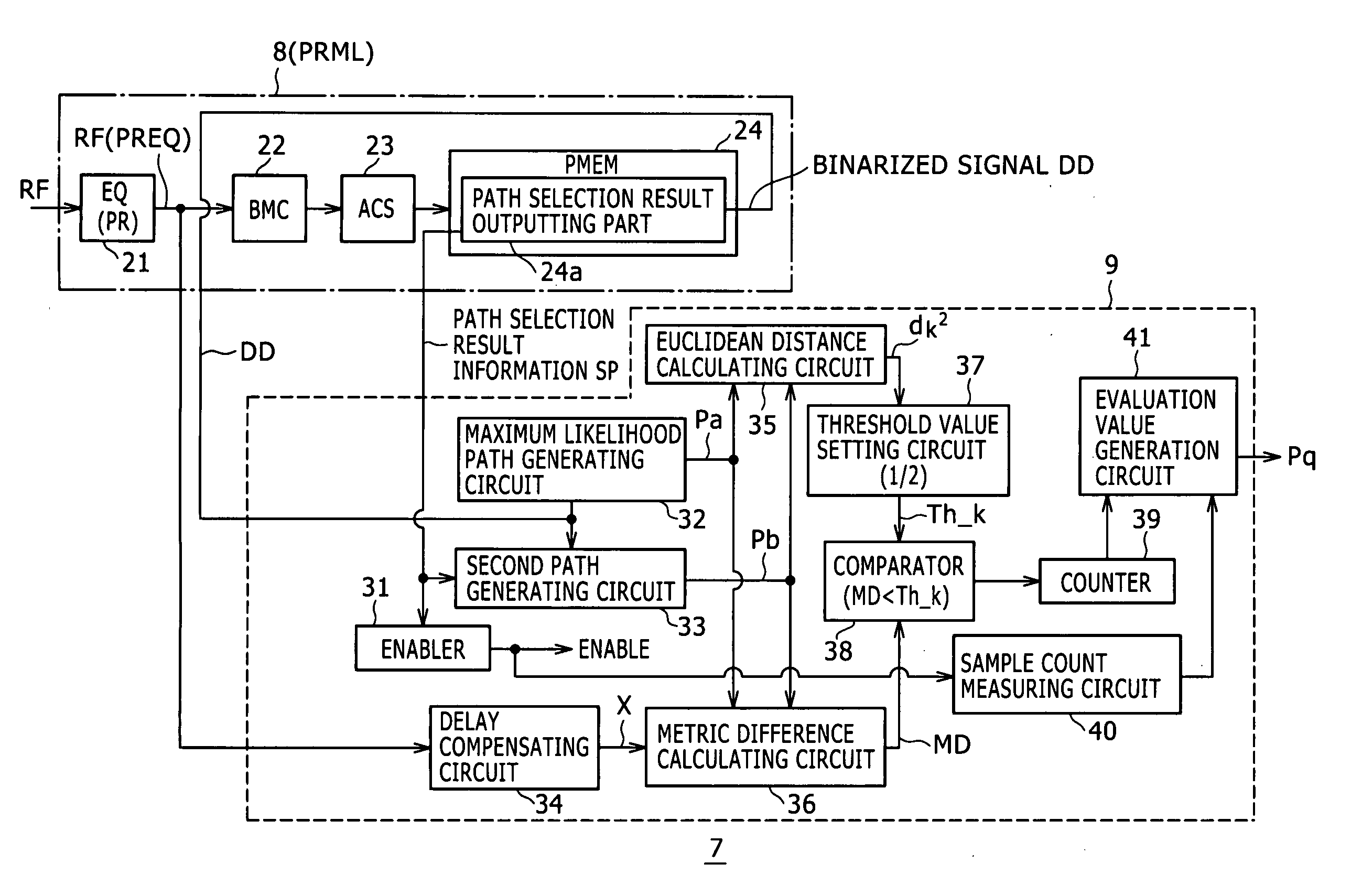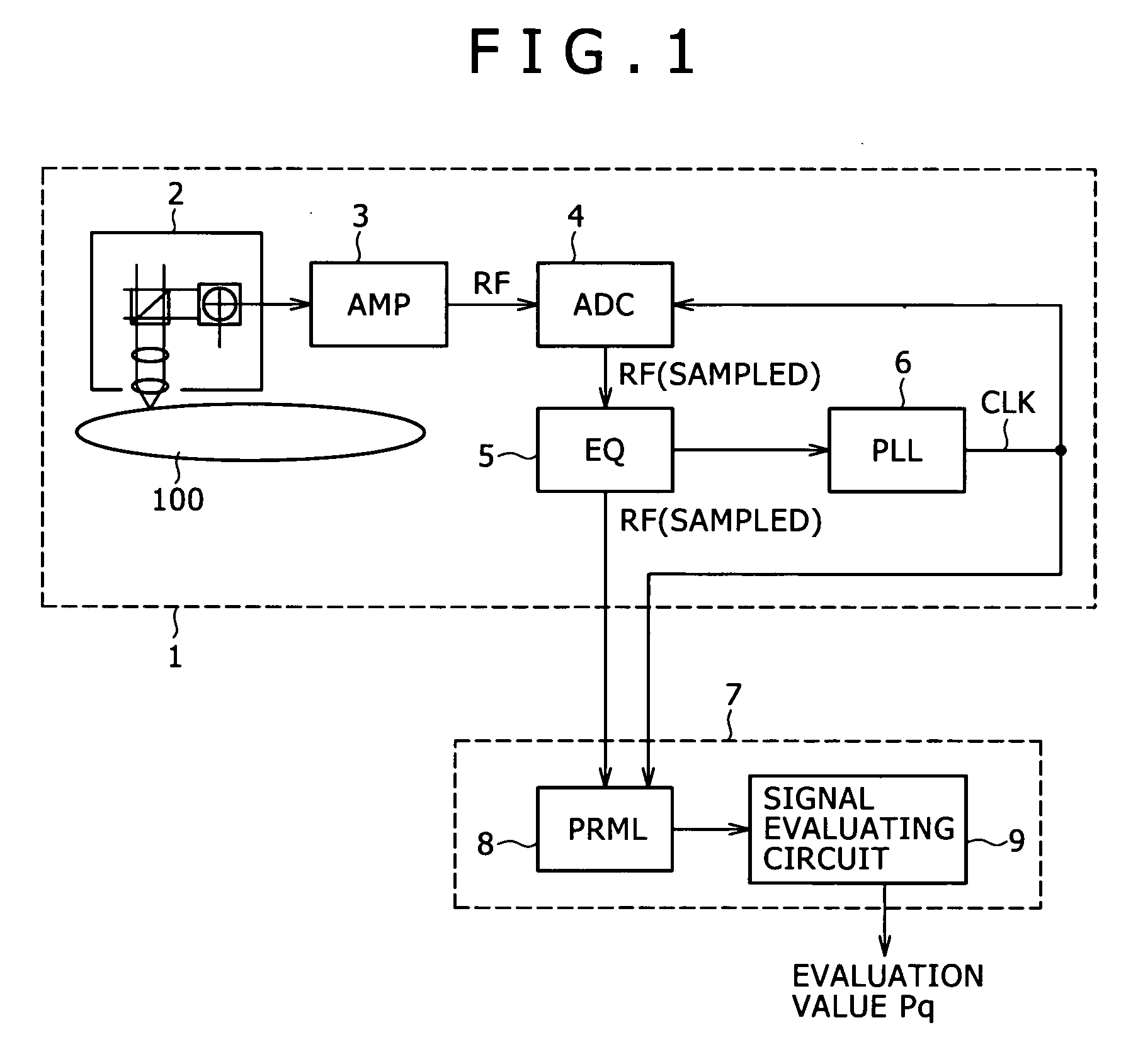Evaluating device, reproducing device, and evaluating method
a technology of reproducing device and evaluation value, which is applied in the direction of amplitude demodulation, instruments, recording signal processing, etc., can solve the problems of affecting the calculation efficiency of the evaluation value, so as to achieve the effect of simplifying the calculation of the evaluation valu
- Summary
- Abstract
- Description
- Claims
- Application Information
AI Technical Summary
Benefits of technology
Problems solved by technology
Method used
Image
Examples
first embodiment
[0093] The path memory updating unit24 in the first embodiment is provided with a path selection result outputting part 24a for outputting the information on the bit sequences of the maximum likelihood path and the second path as path selection result information SP.
[0094] The path selection result information SP output by the path selection result outputting part 24a is supplied to an enabler 31 and the second path generating circuit 33 to be described later within the signal evaluating circuit 9.
[0095] As is understood from the above-described configuration of the PRML decoder 8, a method of bit detection by PRML is an algorithm that compares the magnitudes of a Euclidean distance between a partial response sequence obtained from a correct bit sequence and the reproduced signal RF (that is, a path metric for the correct bit sequence) and a Euclidean distance between a partial response sequence obtained from an erroneous bit sequence and the reproduced signal RF (that is, a path m...
second embodiment
[0190] the present invention will next be described.
[0191]FIG. 7 is a block diagram showing an internal configuration of an evaluating device 7 according to the second embodiment.
[0192] While in the foregoing first embodiment, the path selection result information SP indicating an actual path selection result is referred to to identify an error pattern between a maximum likelihood path Pa and a second path Pb, the second embodiment identifies the error pattern on the basis of a pattern table.
[0193] Incidentally, in FIG. 7, parts already described in the first embodiment are identified by the same reference numerals, and description thereof will be omitted. Description will principally be made of only differences.
[0194] In a PRML decoder 8 in this case, the path selection result outputting part 24a provided in the path memory updating unit 24 is omitted.
[0195] A signal evaluating circuit 9 is provided with a pattern detecting circuit and pattern table 50 shown in FIG. 7. The patt...
third embodiment
[0207] Accordingly, a third embodiment proposes a configuration of an evaluating device 7 corresponding to a case where a configuration of such an adaptive type Viterbi detector is employed.
[0208] An outline of such an adaptive type Viterbi technology will first be described with reference to FIGS. 9A and 9B.
[0209]FIGS. 9A and 9B show relation between reference levels set in a Viterbi detector (PRML detector 8) and a reproduced signal (eye pattern) when PR(1, 2, 2, 1), for example, is employed as a partial response type.
[0210]FIG. 9A shows a case where the amplitude levels in the reproduced signal of mark lengths corresponding respectively to the reference levels (R-Lva to R-Lvg in the figure) in PR employed by the Viterbi detector are ideal levels expected in the PR type.
[0211] On the other hand, FIG. 9B shows a case where a sufficient amplitude cannot be obtained for a reproduced signal of a shortest mark length, in particular, as for example the recording density of the record...
PUM
 Login to View More
Login to View More Abstract
Description
Claims
Application Information
 Login to View More
Login to View More - R&D
- Intellectual Property
- Life Sciences
- Materials
- Tech Scout
- Unparalleled Data Quality
- Higher Quality Content
- 60% Fewer Hallucinations
Browse by: Latest US Patents, China's latest patents, Technical Efficacy Thesaurus, Application Domain, Technology Topic, Popular Technical Reports.
© 2025 PatSnap. All rights reserved.Legal|Privacy policy|Modern Slavery Act Transparency Statement|Sitemap|About US| Contact US: help@patsnap.com



